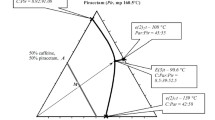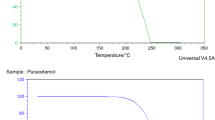Abstract
Caffeine is a widely used drug substance. Two polymorphic forms and one hydrate of caffeine are known. Thanks to scanning transitiometry, the curves pressure versus temperature, P = f(T), of the caffeine were plotted. A (temperature, pressure) unary phase diagram was deduced. It confirms the existence of a new polymorph of caffeine at low pressure synthesized by sublimation. Its identification and its physico-chemical properties were determined using a variety of experimental methods: X-ray powder diffraction, differential scanning calorimeter, thermogravimetric analysis, thermally stimulated current and electrochemical impedance.








Similar content being viewed by others
References
Watters KL, Beal GD. Notes on the water content of crystalline caffeine. J Am Pharm Assoc. 1946;35:12–4.
Sutor DJ. The structure of the pyrimidines and purines. VII. The crystal structure of caffeine. Acta Cryst. 1958;11:453–8.
Gerdil R, March RE. On the arrangement of the water molecules in the crystal structure of caffeine. Acta Cryst. 1960;13:166–7.
Both H, Cammenga K. Composition, properties, stability and thermal dehydration of crystalline caffeine hydrate. Thermochim Acta. 1980;40:29–39.
Bogardus JB. Crystalline anhydrous-hydrate phase changes of caffeine and theophylline in solvent–water mixtures. J Pharm Sci. 1983;72:837–8.
Suzuki E, Shirotani K, Tsuda Y, Sekiguchi K. Water content and dehydration behaviour of crystalline caffeine hydrate. Chem Pharm Bull. 1985;33:5028–35.
Pirttimaki J, Laine E. The transformation of anhydrate and hydrate forms of caffeine at 100 % RH and 0 % RH. Eur J Pharm Sci. 1994;1:203–8.
Griesser UJ, Burger A. The effect of water vapor pressure on desolvation kinetics of caffeine 4/5 hydrate. Int J Pharm. 1995;120:83–93.
Edwards HGM, Lawson E, De Matas M, Shields L, York P. Metamorphosis of caffeine hydrate and anhydrous caffeine. J Chem Soc Perkin Trans. 1997;2:1985–90.
Sabon F, Alberola S, Térol A, Jeanjean B. Sur le polymorphisme et la solubilité. Travaux de la Société de pharmacie de Montpellier. 1979;39:19–24.
Bothe H, Cammenga HK. Phase transitions and thermodynamic properties of anhydrous caffeine. J Therm Anal Calorim. 1979;16:267–75.
Cesaro A, Starec G. Thermodynamic properties of caffeine crystal forms. J Phys Chem. 1980;84:1345–6.
Epple M, Cammenga HK, Sarge SM, Diedrich R, Balek V. The phase transformation of caffeine: investigation by dynamic X-ray diffraction and emanation thermal analysis. Thermochim Acta. 1995;250:29–39.
Lehto VP, Laine E. A kinetic study of polymorphic transition of anhydrous caffeine with microcalorimeter. Thermochim Acta. 1998;317:47–58.
Griesser UJ, Szelagiewicz M, Hofmeir UCh, Pitt C, Cianferan S. Vapor pressure and heat of sublimation of crystal polymorphs. J Therm Anal Calorim. 1999;57:45–60.
Babilev PV, Chiripiko VV (1985) Physicochemical and biopharmaceutic study of polymorphous caffeine modifications. Chemical Abstracts. 103: 92720f.
Descamps M, Correia NT, Derollez P, Danede F, Capet F. Plastic and glassy crystal states of caffeine. J Phys Chem B. 2005;109:16092–8.
Moura JJ, Correia NT, Diogo HP, Descamps M. Dielectric study of the slow motional process in the polymorphic states of anhydrous caffeine. J Phys Chem B. 2006;110:8268–73.
Dong JX, Li Q, Tan ZC, Zhang ZH, Liu Y. The standard molar enthalpy of formation, molar heat capacities, and thermal stability of anhydrous caffeine. J Chem Thermodyn. 2007;39:108–14.
Defossemont G, Ranzio SL, Legendre B. Contributions of calorimetry for C p determination and of scanning transitiometry for the study of polymorphism. Cryst Growth Des. 2004;4(6):1169–74.
Lehmann Ch, Stowasser F. The crystal structure of anhydrous β-caffeine as determined from X-ray powder-diffraction data chemistry. Chem Eur J. 2007;13:2908–11.
Enright GD, Terskikh VV, Brouwer DH, Ripmeester JA. The structure of two anhydrous polymorphs from single-crystal diffraction and ultrahigh-field solid-state 13C NMR spectroscopy. Cryst Growth Des. 2007;7(8):1406–10.
Derollez P, Correia NT, Danède F, Capet F, Affouard F, Lefebvre J, Descamps M. Ab initio structure determination of the high-temperature phase of anhydrous caffeine by X-ray powder diffraction. Acta Crystallogr B. 2005;61:329–34.
Carlucci L, Gavezzotti A. Molecular recognition and crystal energy landscapes: an X-ray and computational study of caffeine and other methylxanthines. Chem A Eur J. 2005;11(1):271–9.
Egawa T, Kamiya A, Takeuchi H, Konaka S. Molecular structure of caffeine as determined by gas electron diffraction aided by theoretical calculations. J Mol Struct. 2006;825:151–7.
Bauer M. Les Techniques de l’Ingénieur. Polymorphisme Origine et méthodes d’étude. 2005;1097:15.
Dichi E, Sghaier M, Fraisse B, Bonhomme F, Keller G. New preparation by sublimation at low pressure of glycine and physico-chemical study. J Alloys Compd. 2007;458:595–601.
Randzio SL. Scanning transitiometry. Chem Soc Rev. 1996;25:383–92.
Randzio SL, Stachowiak Ch, Grolier J-PE. Transitiometric determination of the three-phase curve in asymmetric binary systems. J Chem Thermodyn. 2003;35:639–48.
Randzio SL, Orlowska M. Simultaneous and in situ analysis of thermal and volumetric properties of starch gelatinization over wide pressure and temperature ranges. Biomacromolecules. 2005;6:3045–50.
Wright SF, Phang P, Dollimore D, Alexander KS. An overview of calibration materials used in thermal analysis benzoic acid. Thermochim Acta. 2002;392–393:251–7.
Campel AN, Prodan CA. An apparatus for refined thermal analysis exemplified by a study of the system p-dichlorobenzene-p-dibromobenzene-p-chlorobromobenzene. J Am Chem Soc. 1948;90:553–61.
Andon RJL, Connett J. Calibrants for thermal analysis. Measurement of their enthalpies of fusion by adiabatic calorimetry. Thermochim Acta. 1980;42:241–7.
Della Gatta G, Richardson MJ, Sarge SM, Stolen S. Standards, calibration, and guidelines in microcalorimetry. Pure Appl Chem. 2006;78:1455–76.
Clarke EWW, Glew DN. Evaluation of thermodynamic functions from equilibrium constants. Trans Faraday Soc. 1966;62:539–47.
Narbutt J. The specific heats and heats of melting of dichlorobenzene, bromochlorobenzene, dibromobenzene, bromiodobenzene and diiodobenzenes. Z Elektrochem Angew Phys Chem. 1918;24:339–42.
Legendre B, Sghaier M. Curie temperature of nickel. J Therm Anal Calorim. 2011;105:141–3.
Price DM. Vapor pressure determination by thermogravimetry. Thermochim Acta. 2001;367–368:253–62.
Langmuir I. The vapor pressure of metallic tungsten. Phys Rev. 1913;2:329–42.
Kruif CG, Block JG. The vapour pressure of benzoic acid. J Chem Thermodyn. 1982;14:201–6.
Cox JD (1974) Recommended reference materials for realization of physicochemical properties. Pure Appl Chem 424-4.
Emel’yanenko VN, Verevkin SP. Thermodynamic properties of caffeine: reconciliation of available experimental data. J Chem Thermodyn. 2008;40:1661–5.
Burger A, Ramberger R. On the polymorphism of pharmaceuticals and other molecular crystals. I Theory of thermodynamic rules. Mikrochim Acta. 1979;72:259–71.
Burger A, Ramberger R. On the polymorphism of pharmaceuticals and other molecular crystals. II Applicability of thermodynamic rules. Mikrochim Acta. 1979;72:273–316.
Manduva R, Kett VL, Banks SR, Wood J, Reading M, Craig DQM. Calorimetric and spatial characterization of polymorphic transitions in caffeine using quasi-isothermal MTDSC and localized thermomechanical analysis. J Pharm Sci. 2008;97(3):1285–300.
Gabis V, Lagache M (1981) Les transformations de phases dans les solides minéraux. Société Française de Minéralogie et de Cristallographie, Paris. 1: 14.
Dichi E, Sghaier M, Fraisse B, Bonhomme F. Physico-chemical characterization of γ-amino n-butyric acid nanoparticles. Chem Pharm Bull. 2011;59(6):703–9.
Author information
Authors and Affiliations
Corresponding author
Rights and permissions
About this article
Cite this article
Dichi, E., Legendre, B. & Sghaier, M. Physico-chemical characterisation of a new polymorph of caffeine. J Therm Anal Calorim 115, 1551–1561 (2014). https://doi.org/10.1007/s10973-013-3429-0
Received:
Accepted:
Published:
Issue Date:
DOI: https://doi.org/10.1007/s10973-013-3429-0




